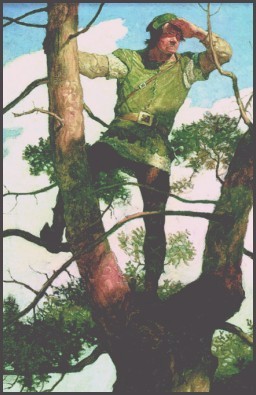

 The quest
for the origins of Robin Hood leads us deep into the
murky forests of medieval England.
The quest
for the origins of Robin Hood leads us deep into the
murky forests of medieval England.
In their Introduction to "The Chronicler's Robin Hood," Stephen Knight and Thomas H. Ohlgren write:
Best known for his stirring adventures, Robin Hood is also an object of study by archivists and historians, seeking traces of a real Robin Hood who might, like the equally elusive King Arthur, be the real figure behind the myths -- or legends, as such historians would want to call them. In 1852 Joseph Hunter found a man called Robin Hood who was actually a valet to King Edward II in the north of England and assumed that he lay behind some of the story of the Gest. But there was no sign that the king's valet was ever thought of as an outlaw. More recently archivists have found other traces of criminals known to the medieval legal authorities as Hood, R.
In fact, it is the Scottish chronicler John Major who first
relocates the Robin Hood story into the late twelfth century, the much more distant time of King John. This is the first time that the outlaw is linked with the period of King Richard. In later hands this was to re-shape Robin's resistance to authority itself as an act of a noble conservatism, since bad King John could be attacked and true kingship defended at the same time. This does not appear to be Major's motif: his redating of the story in the period of John is probably due to the influence of the story of Fouke le Fitz Waryn, a noble outlaw and enemy of bad authority from that period.
[Knight & Ohlgren, Introduction to Historia Majoris Britanniae]
The various essays, ballads, poems, and chronicles are indexed in the Author Menu at The Robin Hood Project; of special interest are:
The Chronicler's Robin Hood , an introductory essay and the relevant (short) selections from Andrew of Wyntoun's Orygynale Chroincle (c. 1420), Walter Bower's Continuation of John of Fordun's Scotichronicon (c. 1440), John Major's Historia Majoris Britanniae (1521), and Richard Grafton's Chronicle at Large (1569).